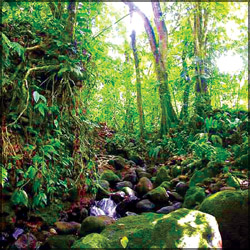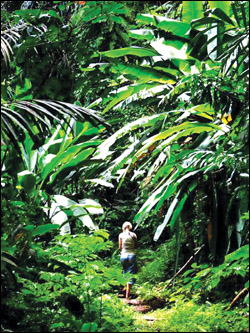Rainforests - home to most tree varieties
 After
a long journey through the world of biomes, here we are at our final
destination. Today, we are exploring the rainforest biome. Do you know
what a tropical rainforest is? It is a forest of tall trees in a region
with year-round heat. An average of 50 to 260 inches (125 to 660 cm) of
rain falls yearly. After
a long journey through the world of biomes, here we are at our final
destination. Today, we are exploring the rainforest biome. Do you know
what a tropical rainforest is? It is a forest of tall trees in a region
with year-round heat. An average of 50 to 260 inches (125 to 660 cm) of
rain falls yearly.
Rainforests belong to the tropical wet climate group. The temperature
in a rainforest rarely goes above 34 degrees Celsius or below 20 degrees
Celsius. Rainfall is often more than 100 inches a year in these forests.
There is usually a short period of less rain. Almost all rainforests lie
near the Equator.
According to the latest records, rainforests cover less than six per
cent of the Earth's land surface. Scientists estimate that more than half of all the world's plant and
animal species live in tropical rainforests. They produce 40 per cent of
the Earth's oxygen.
Scientists estimate that more than half of all the world's plant and
animal species live in tropical rainforests. They produce 40 per cent of
the Earth's oxygen.
Medicinal plants
A tropical rainforest has more kinds of trees than any other area in
the world. About 25 per cent of all the medicines we use come from
plants in rainforests. Curare, which comes from a tropical vine, is used
as an anaesthetic (substance which causes loss of sensation especially
during surgeries).
It also helps to relax muscles during surgery. Quinine, from the
cinchona tree, is used to treat malaria. A person with lymphocyte
leukaemia is said to have a 99 per cent chance of success if treated
with rosy periwinkle. More than 1,400 varieties of tropical plants have
been found to be potential cures for cancer.
Types of trees
All tropical rainforests resemble one another in some way. Many of
the trees have straight trunks that do not branch out for 100 feet or
more. There is no sense in growing branches below the shade where there
is little light.
The majority of the trees have smooth, thin bark because there is no
need to protect them from water loss and freezing temperatures.
Different species
Each of the three largest rainforests, the American, African and
Asian, has a different group of animal and plant species. Each
rainforest has many species of monkeys, all of which differ from the
species of the other two rainforests.
In addition, different areas of the same rainforest may have
different species. Many kinds of trees that grow in the mountains of the
Amazon rainforest do not grow in the lowlands of the same forest.
The four layers
There are four very distinct layers of trees in a tropical
rainforest. These layers are emergent,
upper canopy, understorey, and
forest floor. Emergent trees are
spaced wide apart, and are 100 to 240 feet tall with umbrella-shaped
canopies that grow above the forest. Because emergent trees are exposed
to drying winds, they tend to have small, pointed leaves.
Their root system is very shallow, and to support their size, they
grow buttresses (supports) that can spread out to a distance of 30 feet.
spread out to a distance of 30 feet.
The upper canopy of 60 to 130 foot trees allows light to be easily
available at the top of this layer, but greatly reduces any light below
it. Most of the rainforest's animals live in the upper canopy. There is
so much food available at this level that some animals never go down to
the forest floor.
The understorey, or lower canopy, consists of 60-foot trees. This
layer is made up of the trunks of canopy trees, shrubs, plants and small
trees. There is little air movement. As a result, humidity is constantly
high.
The forest floor is usually completely shaded, except where a canopy
tree has fallen and created an opening. Most areas of the forest floor
receive so little light that few bushes or herbs can grow there.
As a result, a person can easily walk through most parts of a
tropical rainforest. Less than one per cent of the light that strikes
the top of the forest penetrates the forest floor. The top soil is very
thin and of poor quality.
Plant adaptations
Rainforest plants have made many adaptations to their environment.
With over 80 inches of rain per year, plants have made adaptations that
help them shed water off their leaves quickly so the branches are not
weighed down and broken. Many plants have drip tips and grooved leaves,
and some leaves have oily coatings to shed water.
Animal life
Animals in the rainforests depend on the spreading out, blooming and
fruit-bearing of rainforest plants to supply them with a year-round
source of food. Many species of animal life can be found in the
rainforest. Common characteristics found among mammals and birds
(reptiles and amphibians too) include adaptations to a life in the
trees.
Other characteristics are bright colours and sharp patterns, loud
vocalizations and diets heavy on fruits.
Insects make up the largest single group of animals that live in
tropical forests. They include brightly coloured butterflies,
mosquitoes, camouflaged (disgiused) stick insects and huge colonies of
ants.
Compiled by Janani Amarasekara |
